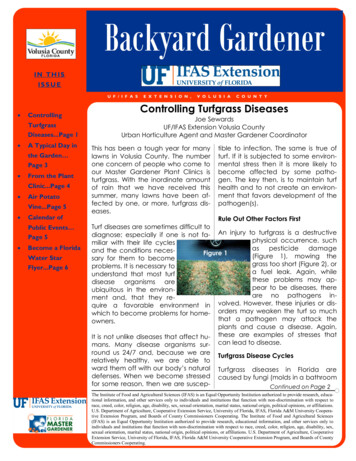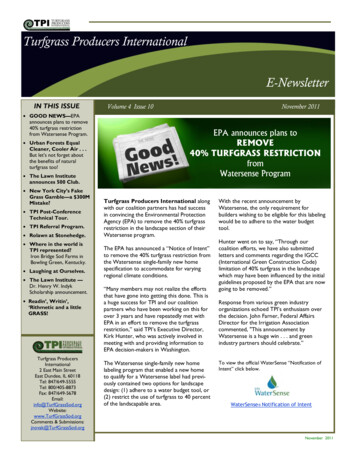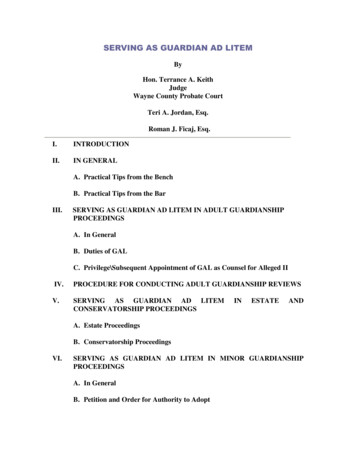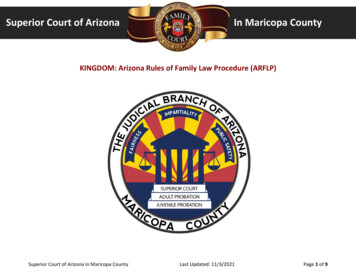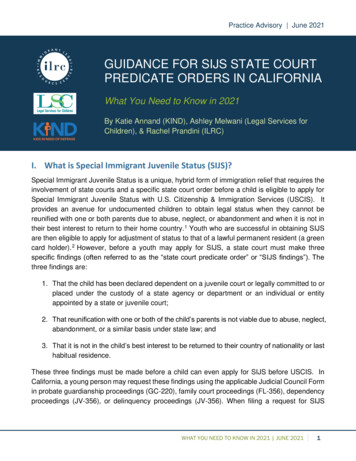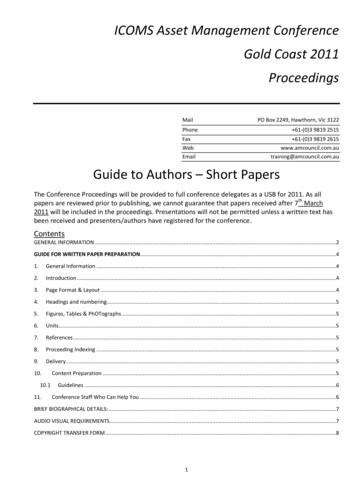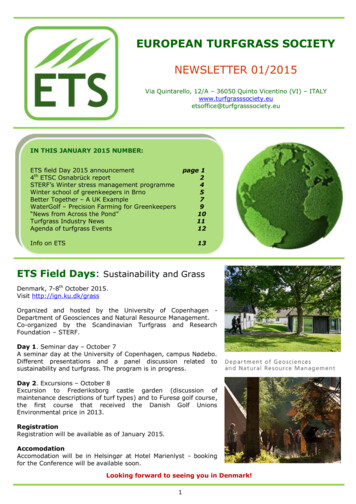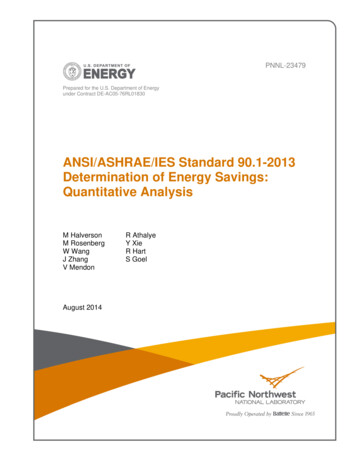
Transcription
2013Turfgrass ProceedingsThe New Jersey Turfgrass AssociationIn Cooperation withRutgers Center for Turfgrass ScienceRutgers Cooperative Extension
2013 RUTGERS TURFGRASS PROCEEDINGSof theGREEN EXPO Turf and Landscape ConferenceDecember 10-12, 2013Trump Taj MahalAtlantic City, New Jerseycovering a wide range of topics and includes technical and popular presentations of importance to theturfgrass industry.The Rutgers Turfgrass Proceedings is publishedyearly by the Rutgers Center for Turfgrass Science,Rutgers Cooperative Extension, and the New JerseyAgricultural Experiment Station, School of Environmental and Biological Sciences, Rutgers, The StateUniversity of New Jersey in cooperation with the NewJersey Turfgrass Association. The purpose of thisdocument is to provide a forum for the disseminationof information and the exchange of ideas and knowledge. The proceedings provide turfgrass managers,research scientists, extension specialists, and industry personnel with opportunities to communicate withco-workers. Through this forum, these professionalsalso reach a more general audience, which includesthe public.This proceedings also includes research papersthat contain original research findings and reviewsof selected subjects in turfgrass science. Thesepapers are presented primarily to facilitate the timelydissemination of original turfgrass research for useby the turfgrass industry.Special thanks are given to those who have submitted papers for this proceedings, to the New JerseyTurfgrass Association for financial assistance, and toBarbara Fitzgerald, Anne Diglio, and Ann Jenkins foradministrative and secretarial support.This publication includes lecture notes of papers presented at the 2013 GREEN EXPO Turf andLandscape Conference. Publication of these lecturesprovides a readily available source of informationDr. Ann Brooks Gould, EditorDr. Bruce B. Clarke, Coordinatori
CONTROL OF PINK SNOW MOLD ON PERENNIAL RYEGRASS WITH FUNGICIDESAND BIORATIONAL PRODUCTS, 2013-2014Bruce B. Clarke, Pradip R. Majumdar, Lisa Beirn, Gerard Rappa, Mark Peacos,Nick Delmar, and Charles Schmid1Fungicides were evaluated for their ability tocontrol pink snow mold (caused by Microdochiumnivale) on two perennial ryegrass (Lolium perenne)tees (#3 and #8) and a fairway (#8) at the Peace PipeCountry Club in Denville, NJ. Turf was established ona sandy loam with a pH of 6.7 in 1995 (both tees) and2008 (fairway #8), respectively. The tees and fairwaywere cut five times per week at 0.375 inches and 0.5inches, respectively, with clippings collected. Fertilizer was applied to all study areas as 46-0-0 (0.50lb nitrogen (N) per 1000 ft2) on 27 August 2013 andas 18-3-17 (0.75 lb N per 1000 ft2) on 23 September2013. Plots were 3 x 5 ft and were arranged in arandomized complete block with four replications.Turf was irrigated to avoid drought stress.Fungicides were applied in water equivalent to1.9 gal per 1000 ft2 with a CO2 powered sprayer at30 psi using 85025 air induction nozzles. Treatments(trt) were applied once on 16 November 2013 whenenvironmental conditions were conducive to pinksnow mold development (Tables 1 to 3). Turf wasinoculated on 4 December 2013 with oat seed (2.2 gper 3 x 5 ft plot) infested with an isolate of M .nivalepreviously obtained from the Peace Pipe Golf Courseand then covered with two layers of an EvergreenEVS Turf Cover (Evergreen, Inc., Mississauga, Ontario) to encourage disease development. Turf coverswere removed from all three studies on 1 April 2014and plots were visually evaluated for percent turf areainfested with pink snow mold, turf quality, color, andphytotoxicity. Turf quality was assessed using a 1 to9 scale, where 9 best turf quality and 5 acceptable quality. Color of foliage was visually estimatedon a 1 to 5 scale, where 1 very chlorotic turf, 2 slight reduction in green color, 3 normal color ofhealthy turf, 4 slight dark green color, and 5 verydark green color. Phytotoxicity was evaluated usinga 1 to 5 scale, where 1 no foliar discoloration, 2 slight chlorosis or necrosis, 3 moderate chlorosis ornecrosis, 4 severe chlorosis or necrosis, and 5 allturf dead. Data were subjected to analysis of varianceand means were separated using the Waller-Duncank-ratio t-test (k 100).Pink snow mold was first observed on 1 April2014 when turf covers were removed. The averagediameter of pink snow mold patches was 4.0 inches.Disease severity of untreated turf was 87, 84 and 91%on fairway #8 (trt 23, Table 1), tee # 8 (trt 20, Table 2),and tee #3 (trt 20, Table 3), respectively, which wasconsidered a very high level of snow mold infestation.Less than 10% turf area infested with pink snow moldrepresented an acceptable level of disease control.A little over half (63%) of the treatments in the threestudies provided acceptable control of pink snow moldduring the evaluation period (16 November 2013 to1 April 2014).On the fairway trial (Table 1), all Interface 2.27SC Mirage 2SC treatments (trts 2 to 4 and 12) exceptInterface 2.27SC @ 3 fl oz Mirage 2SC @ 1.5 fl oz(trt 1) provided good to excellent disease control, asdid Tartan 2.4SC Interface 2.27SC (trt 5), Interface2.27SC (trt 7), SP102000028296 SC @ 6.0 fl oz Mirage 2SC @ 1.5 fl oz (trt 14), SP102000028296 SC@ 8.0 fl oz Mirage 2SC @ 1.5 fl oz (trt 15), Quali-ProTM/C 67WDG QP Ipro 2SC QP Propiconazole14.3LC Foursome 100SL (trt 18), Quali-Pro TM/C67WDG QP Ipro 2SC Tebuconazole 3.6SC Foursome 100SL (trt 19), QP Enclave 5.3F Foursome 100SL (trt 21), and Turfcide 400F 4F (trt 22).Extension Specialist in Turfgrass Pathology, Senior Laboratory Technician, Graduate Assistant, Research Assistant,Senior Greenhouse and Field Technician, Research Assistant, and Graduate Assistant, respectively, New Jersey Agricultural Experiment Station, School of Environmental and Biological Sciences, Rutgers, The State University of NewJersey, New Brunswick, NJ 08901-8520.1331
Similarly, on tee #8 (Table 2), Interface 2.27SCalone (trts 3, 7) or applied with Mirage 2SC (trts 1,2, 12), Tartan 2.4SC (trt 4), Instata 3.6XL (trts 5, 6),SP102000028297 SC alone at rates above 2.862 floz (trts 9 to 11) or applied with Mirage 2SC (trts 13 to15), and Turfcide 400F 4F (trt 18) were very effectiveat suppressing pink snow mold development. For tee#3, good to excellent disease control was affordedby Turfcide 400F 4F Foursome 100SL (trts 1 to 3),Interface 2.27SC Triton 3F (trt 4), Interface 2.27SC Turfcide 4F Foursome 100SL (trt 5), Concert II4.3L Turfcide 4F Foursome 100SL (trt 7), Insignia 2.08SC Turfcide 4F Foursome 100SL (trt 9),Torque 3.6SC 26/36 3.8EC (trt 10), Torque 3.6SC Turfcide 4F Foursome 100SL (trt 11), Instrata3.6XL PAR LC (trt 13), and A13705 1.6SC PARLC (trt 17).Turf quality was acceptable (greater or equal to5.0) for all entries that provided adequate snow moldcontrol in the three studies, except for Turfcide 400F4F (trt 22, Table 1) and the high rate of Instata 3.6XL(9.3 fl oz; trt 6, Table 2) which exhibited a moderatedegree of phytotoxicity (foliar chlorosis and tip burn[winter injury], respectively). Slight to moderate phytotoxicity (greater or equal to 2.0 on a 1 to 5 scale) wasalso observed for turf treated with the lower rate ofInstata 3.6XL (7.0 fl oz; trt 6, Table 1; trt 18, Table 3),Tartan 2.4SC Interface 2.27SC (trt 5) and Quali-ProTM/C 67WDG QP Ipro 2SC QP Propiconazole14.3LC Foursome 100SL (trt 18, Table 1), Chipco26GT 2SC Daconil Ultrex 82.5WDG (trt 17) andTurfcide 400F 4F (trt 18, Table 2), and Concert II 4.3L Banner Maxx 1.3ME (trt 19, Table 2; trt 6, Table 3).Interface 2.27SC @ 5 fl oz Mirage 2SC @ 1.5 fl oz(trt 12, Table 1) and tank mixtures containing Mirage2SC (trts 1, 2, 12, 13, 15, Table 2) had significantlydarker green color compared to untreated turf (trt 22,Table 1; trt 20, Table 2) 136 days post-treatment.332
Table 1. Control of pink snow mold on a perennial ryegrass fairway #8, Peace Pipe Golf Course, Denville NJ: Rutgers University, 3Color4toxicity5Treatment1000 sq. ft.1 April1 April1 April1 April1 Interface 2.27SC. 3.0 fl oz– Mirage 2SC. 1.5 fl oz14.5 fg5.7 c-e5.2 a-c1.4 e-i2 Interface 2.27SC. 4.0 fl oz– Mirage 2SC. 1.5 fl oz7.0 hi5.9 b-d5.4 ab1.7 d-f3 Interface 2.27SC. 4.0 fl oz– Mirage 2SC. 2.0 fl oz6.8 hi5.9 b-d5.0 b-e1.5 e-h4 Interface 2.27SC. 5.0 fl oz– Mirage 2SC. 2.0 fl oz0.8 j6.7 a5.4 ab1.9 de5 Tartan 2.4SC. 1.0 fl oz– Interface 2.27SC. 3.0 fl oz0.8 j5.8 b-d4.9 b-e2.1 cd6 Instrata 3.6XL. 7.0 fl oz15.0 f4.0 h4.4 ef3.1 a7 Interface 2.27SC. 4.0 fl oz5.0 h-j6.3 ab5.2 a-c1.0 j8 SP102000028296 SC. 4.0 fl oz19.0 ef4.7 g5.0 b-e1.1 h-j9 SP102000028296 SC. 5.0 fl oz17.8 ef5.1 e-g5.0 b-e1.0 j10 SP102000028296 SC. 6.0 fl oz16.5 f5.0 fg5.0 b-e1.0 j11 SP102000028296 SC. 8.0 fl oz15.3 f5.4 d-f5.1 a-d1.1 h-j12 Interface 2.27SC. 5.0 fl oz– Mirage 2SC. 1.5 fl oz5.8 h-j5.9 b-d5.7 a1.4 e-i13 SP102000028296 SC. 5.0 fl oz– Mirage 2SC. 1.5 fl oz23.3 de4.7 g5.1 a-d1.1 h-j14 SP102000028296 SC. 6.0 fl oz– Mirage 2SC. 1.5 fl oz8.8 gh5.5 c-f5.2 a-f1.2 g-j15 SP102000028296 SC. 8.0 fl oz– Mirage 2SC. 1.5 fl oz9.0 gh5.6 c-f5.2 a-c1.5 e-h16 Mirage 2SC. 1.5 fl oz51.8 b2.8 i5.0 b-e1.0 j17 Chipco 26GT 2SC. 4.0 fl oz– Daconil Ultrex 82.5WDG. 5.0 oz28.8 cd3.6 h4.6 de1.7 d-f18 Quali-Pro TM/C 67WDG. 6.0 oz– QP Ipro 2SC. 4.0 fl oz– QP Propiconazole 14.3LC. 2.0 fl oz– Foursome 100SL. 0.5 fl oz0.0 j6.0 b-d4.0 ef2.5 bc19 Quali-Pro TM/C 67WDG. 6.0 oz– QP Ipro 2SC. 4.0 fl oz– QP Tebuconazole 3.6SC. 0.6 fl oz– Foursome 100SL. 0.5 fl oz0.5 j6.0 b-d5.4 ab1.7 d-f20 QP Ipro 2SC. 4.0 fl oz– QP Tebuconazole 3.6SC. 1.1 fl oz– Foursome 100SL. 0.5 fl oz34.5 c3.5 h5.0 b-e1.0 j21 QP Enclave 5.3F. 8.0 fl oz– Foursome 100SL. 0.5 fl oz0.3 j6.1 a-c5.5 ab1.3 f-j22 Turfcide 400F 4F. 12.0 fl oz1.8 ij4.7 g3.8 f2.8 ab23 Untreated check. –87.0 a1.5 j5.0 b-e1.0 j(Continued)333
Table 1. Pink snow mold on a perennial ryegrass fairway ty3Color4toxicity5Treatment1000 sq. ft.1 April1 April1 April1 AprilDAT6DATDATDAT136136136136123456Percent turf area infested with pink snow mold per plot (3 x 5 ft). Fungicides were applied in 2.0 gal water per 1,000 sq ft at 30 psi applied with an air induction 85025 nozzle on 16 November 2013. Turf wasinoculated on 4 December with 2.2 g of oat seed per plot infested with an isolate of Microdochium nivaleobtained from the Peace Pipe Golf Course. Turf was covered with two layers of a permeable turf coverto enhance disease development.Values are means of four replicates. Means followed by the same letter are not significantly different according to Waller-Duncan k-ratio t-test (k 100).Turf quality on a scale of 1 to 9, where 9 best turf quality and 5 commercially acceptable quality.Color of foliage, on a scale of 1 to 10, where 5 color of untreated turf, less than 5 increasing foliarnecrosis or chlorosis, and more than 5 increasingly dark green turf.Phytotoxicity on a scale of 1 to 5, where 1 no discoloration, 2 slight foliar chlorosis or necrosis, 3 moderate chlorosis or necrosis, 4 severe chlorosis or necrosis, and 5 all turf dead.Days after last treatment (DAT) application.334
Table 2. Control of pink snow mold on annual bluegrass-perennial ryegrass tee #8, Peace Pipe GolfCourse, Denville NJ: Rutgers University, 3Color4toxicity5Treatment1000 sq. ft.1 April1 April1 April1 April1 Interface 2.27SC. 4.0 fl oz– Mirage 2SC. 2.0 fl oz1.3 g6.9 ab5.7 ab1.3 cd2 Interface 2.27SC. 5.0 fl oz– Mirage 2SC. 2.0 fl oz1.0 g6.9 ab5.5 a-c1.2 cd3 Interface 2.27SC. 6.0 fl oz2.5 e-g6.1 cd5.0 c-f1.0 d4 Tartan 2.4SC. 2.0 fl oz0.8 g6.4 bc5.1 c-f1.1 d5 Instrata 3.6XL. 7.0 fl oz7.5 e5.0 ef4.3 gh1.9 b6 Instrata 3.6XL. 9.3 fl oz5.5 ef4.1 gh4.1 h2.8 a7 Interface 2.27SC. 4.0 fl oz5.3 e-g5.9 cd5.1 c-f1.1 d8 SP102000028297 SC. 2.862 fl oz 23.5 c4.8 ef5.0 c-f1.0 d9 SP102000028297 SC. 3.816 fl oz 7.0 ef6.4 bc5.1 b-e1.2 cd10 SP102000028297 SC. 4.77 fl oz3.3 e-g7.2 a5.3 a-d1.0 d11 SP102000028297 SC. 5.724 fl oz 4.0 e-g7.1 ab5.4 a-d1.0 d12 Interface 2.27SC. 5.0 fl oz– Mirage 2SC. 1.5 fl oz2.5 e-g7.4 a5.5 a-c1.1 d13 SP102000028297 SC. 3.816 fl oz – Mirage 2SC. 1.5 fl oz4.8 e-g7.3 a5.4 a-d1.0 d14 SP102000028297 SC. 4.77 fl oz– Mirage 2SC. 1.5 fl oz3.3 e-g6.9 ab5.8 a1.0 d15 SP102000028297 SC. 5.724 fl oz – Mirage 2SC. 1.5 fl oz2.3 fg7.3 a5.8 a1.0 d16 Mirage 2SC. 1.5 fl oz28.8 b3.7 h5.0 c-f1.6 bc17 Chipco 26GT 2SC. 4.0 fl oz– Daconil Ultrex 82.5WDG. 5.0 oz24.0 bc4.4 f-h4.7 e-g2.0 b18 Turfcide 400F 4F. 12.0 fl oz0.5 g5.4 de4.8 d-g2.1 b19 Concert II 4.3L. 8.5 fl oz– Banner Maxx 1.3ME. 1.0 fl oz14.3 d4.7 e-g4.5 f-h2.0 b20 Untreated check. –83.8 a1.7 i4.9 d-g1.0 dDAT6DATDATDAT1361361361361234Percent turf area infested with pink snow mold per plot (3 x 5 ft). Fungicides were applied in 2.0 gal water per 1,000 sq ft at 30 psi applied with an air induction 85025 nozzle on 16 November 2013. Turf wasinoculated on 4 December with 2.2 g of oat seed per plot infested with an isolate of Microdochium nivaleobtained from the Peace Pipe Golf Course. Turf was covered with two layers of a permeable turf coverto enhance disease development.Values are means of four replicates. Means followed by the same letter are not significantly different according to Waller-Duncan k-ratio t-test (k 100).Turf quality on a scale of 1 to 9, where 9 best turf quality and 5 commercially acceptable quality.Color of foliage, on a scale of 1 to 10, where 5 color of untreated turf, less than 5 increasing foliarnecrosis or chlorosis, and more than 5 increasingly dark green turf.(Continued)335
Table 2. Pink snow mold on annual bluegrass-perennial ryegrass tee # 8 (continued).56Phytotoxicity on a scale of 1 to 5, where 1 no discoloration, 2 slight foliar chlorosis or necrosis, 3 moderate chlorosis or necrosis, 4 severe chlorosis or necrosis, and 5 all turf dead.Days after last treatment (DAT) application.336
Table 3. Control of pink snow mold on annual bluegrass-perennial ryegrass tee #3, Peace Pipe GolfCourse, Denville NJ: Rutgers University, 3Color4toxicity5Treatment1000 sq. ft.1 April1 April1 April1 April12345678910111213141516171819Turfcide 400F 4F. 8.0 fl oz Foursome 100SL. 0.5 fl ozTurfcide 400F 4F. 12.0 fl oz Foursome 100SL. 0.5 fl ozTurfcide 4F. 16.0 fl oz Foursome 100SL. 0.5 fl ozInterface 2.27SC. 3.0 fl oz Triton 3F. 0.75 fl ozInterface 2.27SC. 3.0 fl oz Turfcide 4F. 8.0 fl oz Foursome 100SL. 0.5 fl ozConcert II 4.3L. 8.5 fl oz Banner Maxx 1.3ME. 1.0 fl ozConcert II 4.3L. 8.5 fl oz Turfcide 4F. 8.0 fl oz Foursome 100SL. 0.5 fl ozInsignia 2.08SC. 0.7 fl oz Trinity 1.69L. 1.0 fl ozInsignia 2.08SC. 0.7 fl oz Turfcide 4F. 8.0 fl oz Foursome 100SL. 0.5 fl ozTorque 3.6SC. 0.9 fl oz 26/36 3.8EC. 4.0 fl ozTorque 3.6SC. 0.9 fl oz Turfcide 4F. 8.0 fl oz Foursome 100SL. 0.5 fl ozA20744A 50W. 0.7 oz PAR LC. 0.36 fl ozInstrata 3.6XL. 7.0 fl oz PAR LC. 0.36 fl ozSecure 4.17SC. 0.5 fl oz PAR LC. 0.36 fl ozA13705 1.6SC. 2.6 fl oz Secure 4.17SC. 0.5 fl oz PAR LC. 0.36 fl ozA20744A 50W. 0.5 oz Secure 4.17SC. 0.5 fl oz PAR LC. 0.36 fl ozA13705 1.6SC. 2.6 fl oz PAR LC. 0.36 fl ozInstrata 3.6XL. 7.0 fl ozChipco 26GT 2SC. 4.0 fl oz Daconil Ultrex 82.5WDG. 5.0 .3––12.5––39.8–9.012.5–28.8g-j6.2 cd5.3 a-d1.0 dh-j6.4 b-d5.0 c-e1.0 dij7.3 ab5.1 b-e1.1 dh-j6.1 d5.4 a-d1.3 cdj7.6 a5.6 ab1.0 df4.2 g4.8 e2.1 aj6.4 b-d5.2 b-e1.9 abde4.1 g4.9 de1.0 dh-j7.1 a-c5.5 a-c1.0 dj6.0 d4.8 e1.8 abij7.1 a-c5.6 ab1.0 db2.6 h5.6 ab1.0 dg-i5.1 ef5.8 a1.6 bcc3.6 g5.2 b-e1.1 dfg5.7 de5.3 b-e1.1 dd3.8 g5.3 b-e1.1 dghfg5.9 de4.2 fg5.6 ab5.1 b-e1.9 a2.0 ae4.4 fg5.0 c-e1.0 d(Continued)337
Table 3. Pink snow mold on annual bluegrass-perennial ryegrass tee #3 ty3Color4toxicity5Treatment1000 sq. ft.1 April1 April1 April1 April20 Untreated check. –91.3 a1.3 i5.0 c-e1.0 dDAT6DATDATDAT136136136136123456Percent turf area infested with pink snow mold per plot (3 x 5 ft). Fungicides were applied in 2.0 gal water per 1,000 sq ft at 30 psi applied with an air induction 85025 nozzle on 16 November 2013. Turf wasinoculated on 4 December with 2.2 g of oat seed per plot infested with an isolate of Microdochium nivaleobtained from the Peace Pipe Golf Course. Turf was covered with two layers of a permeable turf coverto enhance disease development.Values are means of four replicates. Means followed by the same letter are not significantly different according to Waller-Duncan k-ratio t-test (k 100).Turf quality on a scale of 1 to 9, where 9 best turf quality and 5 commercially acceptable quality.Color of foliage, on a scale of 1 to 10, where 5 color of untreated turf, less than 5 increasing foliarnecrosis or chlorosis, and more than 5 increasingly dark green turf.Phytotoxicity on a scale of 1 to 5, where 1 no discoloration, 2 slight foliar chlorosis or necrosis, 3 moderate chlorosis or necrosis, 4 severe chlorosis or necrosis, and 5 all turf dead.Days after last treatment (DAT) application.338
The New Jersey Turfgrass Association In Cooperation with . and then covered with two layers of an Evergreen EVS Turf Cover (Evergreen, Inc., Mississauga, On-tario) to encourage disease development. . 136 days post-treatment. 333 Table 1. Control of pink snow mold on a perennial ryegrass fairway #8, Peace Pipe Golf Course, Den-ville NJ .

